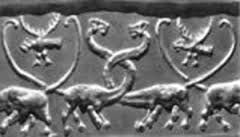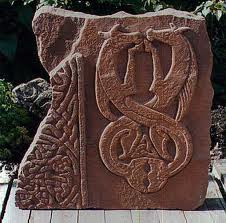It looks like you're using an Ad Blocker.
Please white-list or disable AboveTopSecret.com in your ad-blocking tool.
Thank you.
Some features of ATS will be disabled while you continue to use an ad-blocker.
share:
a reply to: Wifibrains
Wow thanks that's trippy.
Your link broke but here it is:
Spirit Level
Bull's Eye Level
I thank you for blowing my mind with this uncanny synchronization you kindly provided.
I am addicted to that feeling....
Wow thanks that's trippy.
Your link broke but here it is:
Spirit Level
Bull's Eye Level
I thank you for blowing my mind with this uncanny synchronization you kindly provided.
I am addicted to that feeling....
originally posted by: Wifibrains
a reply to: muzzleflash
Me too! Lol.
Here is the rest of it...
www.abovetopsecret.com...
Haha, I don't remember when you posted that but I already flagged it back when you did it.
*Unless I lost my mind and unknowingly flagged it today, but I don't think so*
I have been going through so many words in funky ways I honestly don't remember lol.
But I did so I obviously read and liked it a lot because I almost never flag threads. It's rare.
You are right though about what you said.
That's how those holes get drilled !
It's all about Balance!
Also I have a question I'll ask it in your old thread tho since it's about what you said there.
a reply to: muzzleflash
Lolololol!
If you don't know how you do it, then I can't possibly know! And yet..and yet....dragons coming from China, along the Silk Road, through Scythia and into Celtic myth can be seen to make sense given the hundreds and hundreds of years these processes happened.
There's so little written about these links, I know zilch about the Chinese bronze age/iron age era.
It also starts to make sense of the swastika links too, because this:
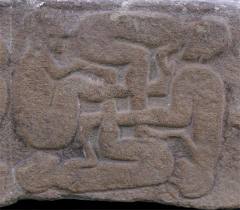
and this:
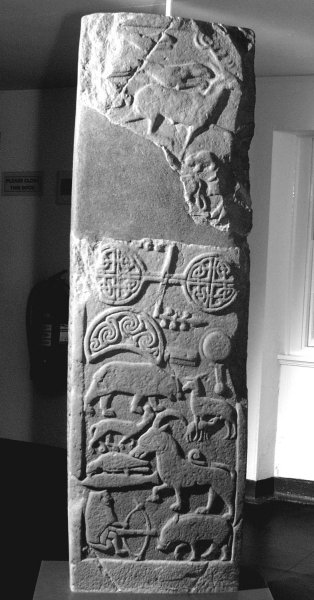
and by association then, the Z rod alone can be seen as having it's roots in:

Lolololol!
If you don't know how you do it, then I can't possibly know! And yet..and yet....dragons coming from China, along the Silk Road, through Scythia and into Celtic myth can be seen to make sense given the hundreds and hundreds of years these processes happened.
There's so little written about these links, I know zilch about the Chinese bronze age/iron age era.
It also starts to make sense of the swastika links too, because this:

and this:

and by association then, the Z rod alone can be seen as having it's roots in:

a reply to: Logarock
Shhh! Don't tell everyone, lol!
I guess I'm wondering how much of that is true, really, if the two traditions didn't grow together with the Black sea region being the link between the cultures. It's just a thought, and there's no way of verifying it really. I was so surprised to hear that the Chinese knew of the Romans last night, but on reflection, why wouldn't they? I'm having my narrow historical mind expanded here!
I did read something I thought you'd be interested in though. Agricola has always puzzled me - his name means 'farmer' if my school latin serves me right. Aha, but that wasn't his name. His name was Gnaeus Julius Luci, son of Aniensis Agricola, from the forum Julii. A Gaul with a Celtic mother (Procilla), indeed!
Shhh! Don't tell everyone, lol!
There are two distinct cultural traditions of dragons: the European dragon, derived from European folk traditions and ultimately related to Greek and Middle Eastern mythologies, and the Chinese dragon, with counterparts in Japan (namely the Japanese dragon), Korea and other East Asian countries.[1]
The two traditions may have evolved separately, but have influenced each other to a certain extent, particularly with the cross-cultural contact of recent centuries. The English word "dragon" derives from Greek δράκων (drákōn), "dragon, serpent of huge size, water-snake".[2]
I guess I'm wondering how much of that is true, really, if the two traditions didn't grow together with the Black sea region being the link between the cultures. It's just a thought, and there's no way of verifying it really. I was so surprised to hear that the Chinese knew of the Romans last night, but on reflection, why wouldn't they? I'm having my narrow historical mind expanded here!
I did read something I thought you'd be interested in though. Agricola has always puzzled me - his name means 'farmer' if my school latin serves me right. Aha, but that wasn't his name. His name was Gnaeus Julius Luci, son of Aniensis Agricola, from the forum Julii. A Gaul with a Celtic mother (Procilla), indeed!
A Celtic coin, 60-50 BC, with a swastika on the reverse:
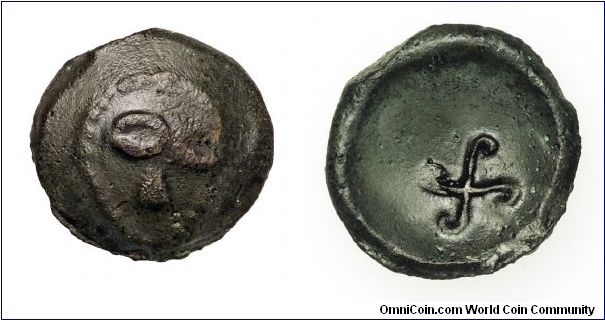
From the same collection, from 40-30 BC, this one has the inscription PIXTIL, which is curious:
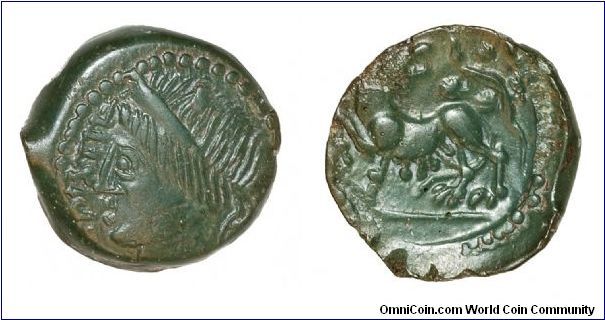
Coin people.com

From the same collection, from 40-30 BC, this one has the inscription PIXTIL, which is curious:

Coin people.com
edit on 8-5-2014 by beansidhe because: source
The coins shown above were minted by the Carnutes, a Celtic group from central France:
Wiki link
Hmm, quite interesting, crescents, eagles etc. But not as interesting as their neighbours!!!!!
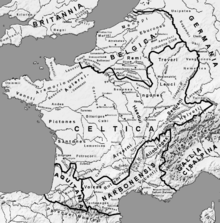
Follow the wiki link for a clickable map. On the mid-western coast (just by the C of Celtica) there is a tribe called the Pictones...
The iconography of their numismatics includes the motifs of heads with traditional Celtic torcs; a wolf with a star; a galloping horse; and the triskelion. Many coins show an eagle with the lunar crescent, with a serpent, or with a wheel with six or four spokes, or a pentagrammatic star, or beneath a hand holding a branch with berries, holly perhaps. The wheel with four spokes forms a cross within a circle, an almost universal image since Neolithic times. Sometimes the circle is a ring of granules. Among the Celts, the ring and spokes may represent the cycle of the year divided in its four seasons, rather than the sun, which is a common meaning among cultures.[1] See Cross.
Wiki link
Hmm, quite interesting, crescents, eagles etc. But not as interesting as their neighbours!!!!!

Follow the wiki link for a clickable map. On the mid-western coast (just by the C of Celtica) there is a tribe called the Pictones...
a reply to: Logarock
There's long been a link between Scotland and France, such as the Auld Alliance
As far as the Templars, it goes back much further:
Knights Templar in Scotland
(Drumchapel etc are in Glasgow, just to the west).
This group are looking at the connections between France, the Templars, the Masons and of course, our beloved Rosslyn:
Rosslyn Templars
There's long been a link between Scotland and France, such as the Auld Alliance
The alliance dates from the treaty signed by John Balliol and Philip IV of France in 1295 against Edward I of England. The terms of the treaty stipulated that if either country was attacked by England, the other country would invade English territory, as became evident at the Battle of Flodden Field, 1513.
As far as the Templars, it goes back much further:
The Knights Templar were formed in 1118 by Hugh de Payens in order to protect the road to Jerusalem from the Muslims and Jews. They were a combination of monk and soldier, similar to the Knights Hospitaller formed earlier to treat the sick from the crusades. Both orders spread quickly throughout Europe and it is probably in the reign of David I that both were endowed lands in Scotland. The Knights Templar were granted lands near Drumchapel:- Temple (hence the name, at Anniesland), Jordanhill (named after the middle-eastern land by the Templars) and the surrounding woodland that became known as Knightswood; parts of Knightswood are named North and South Templar. Both Sides of the burn states: 'Most of Knightswood estate was a detached portion of Jordanhill estate though much had an ancient and honourable history of its own. The name commemorates the Knights Templar who had been granted these lands and the wood for their services in the crusades.'
Knights Templar in Scotland
(Drumchapel etc are in Glasgow, just to the west).
This group are looking at the connections between France, the Templars, the Masons and of course, our beloved Rosslyn:
Rosslyn Templars
edit on 9-5-2014 by beansidhe because: (no reason
given)
a reply to: beansidhe
PICTONES! Lovin' that one. (Make a good name for a band??)
Did you know that the Pictones were skilled naval architects and sailors?
And that they TRADED WITH the British Isles??????
Very Interesting!
Nice one Beans!
I owe you a pickled onion monster munch!
PICTONES! Lovin' that one. (Make a good name for a band??)
Did you know that the Pictones were skilled naval architects and sailors?
And that they TRADED WITH the British Isles??????
WIKI LINK
from wiki: The region was known for its timber resources and occasionally traded with the Roman province of Transalpine Gaul. Additionally, the Pictones traded with the British Isles from the harbor of Ratiatum (Rezé), which served as an important port linking Gaul and Roman Britain.
Very Interesting!
Nice one Beans!
I owe you a pickled onion monster munch!
a reply to: Gordi The Drummer
It would make a good name - I was thinking they were like a Bluetones version of our Picts! (Although our Picts were said to have blue tones, so who knows...)
But no, I didn't know that about them, cheers for the link. I was wondering why the Romans would name both people the same name. I see from your link that they both lived in Pictavia. This is interesting, very interesting.
I'll hold you to those monster munch lololollol!
It would make a good name - I was thinking they were like a Bluetones version of our Picts! (Although our Picts were said to have blue tones, so who knows...)
But no, I didn't know that about them, cheers for the link. I was wondering why the Romans would name both people the same name. I see from your link that they both lived in Pictavia. This is interesting, very interesting.
I'll hold you to those monster munch lololollol!
Hi Folks,
I've just spent the last couple of hours with my chin on the deck! going Huh???? Really???? Wow???? No Way!!!!
Has anyone seen TRACKING LADON GOG AND THE HEBREW ROSE at tribwatch.com ??
It's a looong and quite rambling "quest" to track an ancient line of people who's descendants formed the templars, zionists and illuminati.
But it touches on some AMAZING stuff, including the Arthurian legends being encoded/encrypted REAL histories, where the individual characters (Arthur, Lancelot, Guinevere etc) all represent races / tribes / bloodlines / places in ancient times.
The author posts some very convincing arguments, and there are loads of links displayed between ancient Greece / Thrace etc and the British Isles. He mentions the Dan too in later chapters.
If his thinking is correct, many of his ideas overlap with what we've been discussing here.
He even refers to the ancient bloodline as the "Dragon Cult"!!!!!
Fascinating read, but I'm getting lost in it because of the way it's written as a series of rambling "think out loud" chapters!!! HELP! Someone go and help figure out if it all fits? Please?? LOL
Here's a quote from the preface:
LINK TO THE TRIBWATCH SITE HERE
Enjoy!
cheers,
Big G
I've just spent the last couple of hours with my chin on the deck! going Huh???? Really???? Wow???? No Way!!!!
Has anyone seen TRACKING LADON GOG AND THE HEBREW ROSE at tribwatch.com ??
It's a looong and quite rambling "quest" to track an ancient line of people who's descendants formed the templars, zionists and illuminati.
But it touches on some AMAZING stuff, including the Arthurian legends being encoded/encrypted REAL histories, where the individual characters (Arthur, Lancelot, Guinevere etc) all represent races / tribes / bloodlines / places in ancient times.
The author posts some very convincing arguments, and there are loads of links displayed between ancient Greece / Thrace etc and the British Isles. He mentions the Dan too in later chapters.
If his thinking is correct, many of his ideas overlap with what we've been discussing here.
He even refers to the ancient bloodline as the "Dragon Cult"!!!!!
Fascinating read, but I'm getting lost in it because of the way it's written as a series of rambling "think out loud" chapters!!! HELP! Someone go and help figure out if it all fits? Please?? LOL
Here's a quote from the preface:
This book assumes that mainline Greek, Roman, Babylonian, Egyptian, Celtic, Norse and Arthurian mythology is the real history, but written in code, of a pagan/occult Semite peoples responsible for the gross exploitation of mankind and ultimately for Armageddon. In modern times, some of their numbers developed into secret societies: Rosicrucians, Templars, Zionists, and Illuminatii.
LINK TO THE TRIBWATCH SITE HERE
Enjoy!
cheers,
Big G
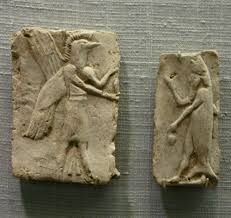
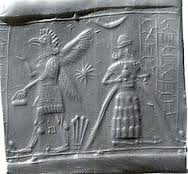
Heres your birdmen. Top Syrian bottom Babylonian. Something like these may have been posted back at the point we were talking about this. This also goes to what Gordi posted.
Z rod alert! Z rod alert!
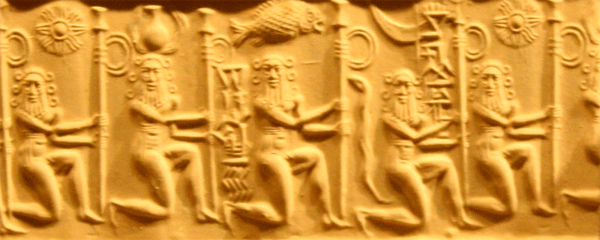
Found this while looking deep into the feminine lunar. Its Akkadian.
4th section over, moon slice, snake and Z.
Jee Zee Akkad

Found this while looking deep into the feminine lunar. Its Akkadian.
4th section over, moon slice, snake and Z.
Jee Zee Akkad
edit on 9-5-2014 by Logarock because: n
a reply to: Gordi The Drummer
He's quite hard to follow, I see what you mean. He jumps about from subjects too quickly for my tiny mind to follow him, and I haven't read it all thoroughly enough to absorb all his knowledge of myths. He makes some big assumptions in there based on names alone but there are some real gems there. This is the one I'm wondering about at the moment, but I'm going back in for more!
The Calydonian Boar
My Calydonian Boar Hunt
He makes a lot more connections, including our friend Twyrch, noting that this boar story was simply carried over from the original to explain tribal alliances. He's also very keen on the Alba Longa/Alba/Albania connection, Log.
I need to spend more time on this!
He's quite hard to follow, I see what you mean. He jumps about from subjects too quickly for my tiny mind to follow him, and I haven't read it all thoroughly enough to absorb all his knowledge of myths. He makes some big assumptions in there based on names alone but there are some real gems there. This is the one I'm wondering about at the moment, but I'm going back in for more!
The Calydonian Boar
The Calydonian Boar (Greek: ὁ Καλυδώνιος κάπρος[2][3] or ὁ Καλυδώνιος ὗς[4]) is one of the monsters of Greek mythology that had to be overcome by heroes of the Olympian age. Sent by Artemis to ravage the region of Calydon in Aetolia because its king failed to honor her in his rites to the gods, it was killed in the Calydonian Hunt, in which many male heroes took part, but also a powerful woman, Atalanta, who won its hide by first wounding it with an arrow.
My Calydonian Boar Hunt
Here's what myth reveals. The Aeetes kingdom in Greece was that of Corinth. Aeetes had left that kingdom to Bunus, son of Hermes, and that appears as a variation of "Pan." Now "pig/swine" in Greek is "choiros," and per chance "Corinth" was named after a pig/boar. I read online that "Corinth" means "immoral" and "satiated," two words where "pig" can substitute. Thus it could be that the Hermes line in Corinth attacked the Calydonians upon their return.
Indeed, for Jason, upon that return with his new wife, Medea (daughter of Aeetes), settles with her in Corinth. Not surprising, since Corinthians at that time were as related to Medea as they were to her father. Jason decides that he wants to re-marry (i.e. form alliances) with the princess of Corinth, sometimes named Creusa, and Medea is forced to flee the city (the historical reason not decipherable), which she does do on a chariot belonging to Helios (her grandfather), a chariot pulled by winged dragons. That symbolism is crucial, for it came to be, and still is, the symbol of Wales.
And so the Calydonian descendants of Oeneus (perhaps Gypsies included) were scattered and had to remove elsewhere. The region south of the Po river (Italy), immediately to the south of the Veneti, was named "Romagna," evoking the Gypsies in their "Roma" designation." Next to (west of) Romagna, and likewise on the Po river, was the Duchy of Modena (also "Mutina"), and that term reflects "Modon," the variation of "Methoni."
He makes a lot more connections, including our friend Twyrch, noting that this boar story was simply carried over from the original to explain tribal alliances. He's also very keen on the Alba Longa/Alba/Albania connection, Log.
I need to spend more time on this!
edit on 9-5-2014 by beansidhe because: source
new topics
-
This is adorable you guys!
General Chit Chat: 8 hours ago -
Reprehensible Behavior
US Political Madness: 8 hours ago -
Defending the need for adherence to Old Testament commandments under the new covenant of Christ
Conspiracies in Religions: 9 hours ago
top topics
-
Reprehensible Behavior
US Political Madness: 8 hours ago, 10 flags -
Those Drones over NJ and elsewhere
Aliens and UFOs: 14 hours ago, 8 flags -
South Korean coup was an attempt to start WW3
World War Three: 14 hours ago, 7 flags -
This is adorable you guys!
General Chit Chat: 8 hours ago, 7 flags -
Archer aviation and the NJ drones
Aircraft Projects: 14 hours ago, 5 flags -
Defending the need for adherence to Old Testament commandments under the new covenant of Christ
Conspiracies in Religions: 9 hours ago, 5 flags
active topics
-
-@TH3WH17ERABB17- -Q- ---TIME TO SHOW THE WORLD--- -Part- --44--
Dissecting Disinformation • 3709 • : WeMustCare -
Drones everywhere in New Jersey ---and Elsewhere Master Thread
Aliens and UFOs • 174 • : nugget1 -
Defending the need for adherence to Old Testament commandments under the new covenant of Christ
Conspiracies in Religions • 16 • : randomuser2034 -
The Mystery Drones and Government Lies --- Master Thread
Political Conspiracies • 106 • : cherokeetroy -
Statements of Intent from Incoming Trump Administration Members - 2025 to 2029.
2024 Elections • 45 • : WeMustCare -
Former DNI-Congressman John Ratcliffe says the U.S. Government is Intimidated by UFOs.
Aliens and UFOs • 42 • : anthelion -
Post A Funny (T&C Friendly) Pic Part IV: The LOL awakens!
General Chit Chat • 7912 • : imitator -
This is adorable you guys!
General Chit Chat • 4 • : CriticalStinker -
The Acronym Game .. Pt.4
General Chit Chat • 1016 • : FullHeathen -
Could rampant land speculation have caused the Civil War?
History • 35 • : matafuchs


